
Light Rail Now/Light Rail Progress can be contacted at: Light Rail Now! |
Particularly in the context of the ferocious campaign against rail transit waged by Highways, Inc. (the decades-old collaboration among the US highway and motor-vehicle lobbies and federal and state governments), the Light Rail Now Project has endeavored to advance a strong case for rail transit solutions to public transportation needs. But aren't there situations where bus-based transit services, such as so-called "Bus Rapid Transit" (aggressively promoted by the Federal Transit Administration, or FTA), would be the preferred choice? Serious public transportation advocates emphasize that a multi-modal approach to transit development is the policy most likely to meet public needs – and that no one, single mode can possibly meet all needs. From its inception, the Light Rail Now Project has energetically supported such a multi-modal approach to public transport, and this definitely includes improved and innovative bus service, like Quality Bus (a more accurate and preferable term for the "fuzzy" range of higher-quality bus services commonly designated as "Bus Rapid Transit", or "BRT").
Our efforts, including the Light Rail Now! (LRN!) website, have consistently emphasized the value of these transit improvements; but, unfortunately, much of our discussion of "BRT" of necessity is focused on challenging the avalanche of exaggerated and deceptive claims made by its promoters, including some within the FTA and other government agencies. The LRN! website attempts to provide a kind of "reality check" on this issue, while vigorously supporting bona fide, cost-effective improvements to the quality of bus service. Here are some examples. In our Photo Gallery section "Bus Rapid Transit" (BRT) and Quality Bus Service we point out that
"Bus Rapid Transit" (BRT) in North America seems to be applied to almost
anything above basic local bus service. In Europe, what's called "BRT" in North
America would equate to what is simply widespread, high-quality, attractive bus
service – i.e., a "Better Bus" or Quality Bus service. These photos illustrate the
wide range of these kinds of services – what innovations and improvements are
possible, what kinds of benefits can be gained, and what weaknesses are
encountered. In our article "Bus Rapid Transit" or "Quality Bus"? Reality Check we discuss this issue further: While improvements in basic bus transit services, by whatever name, are direly
needed in North American cities, what is actually meant by "BRT"? The concept
seems to be applied, by some of its most ardent proponents, to a wide swath of
concepts – in effect, virtually any type of long-haul bus transit above regular local
service in mixed street traffic or slow circulator/connector services. Quality Bus? Good idea! Thus, it is evident that, in virtually every case in North America, and even in
world "model" cases such as in Curitiba, the term "Bus Rapid Transit" is
misapplied. Light Rail Progress suggests that "QB" – Quality Bus service – would
be a more descriptive term for such bus service improvements than "BRT".
(indeed, Europe, which has far outpaced North America in aggressively
implementing and expanding such services, has all but ignored the "BRT" epithet
in vogue in North America. Instead, Quality Bus service appears to be the
preferred, and more accurately descriptive, term applied in Europe to these
services.) And certainly, such Quality Bus services are an essential element of
the total mix of modes – including LRT and even grade-separated rapid transit
and innovative "gadget" systems in some cases – which contribute to making
public transport a truly attractive, effective, and significant component of the
mobility system, and mobility choices available to the community, in today's urban
areas. So, what situations are optimal for Quality Bus ("BRT") – and how do these compare
with applications suitable for rail transit? it's helpful to keep in mind that rail transit
consists of a fairly wide spectrum of possible options – some of them at the lower-cost
end of the range, such as regional ("commuter") rail services and a variety of light rail
transit (LRT) alternatives, including both modern and heritage-type streetcar modes. In the assessment of the Light Rail Now Project, Quality Bus services are generally
most relevant where capital investment is well under a threshold where some form
of rail transit might be competitive, or where the bus innovation can function as a viable precursor
to rail – and, in addition, where the bus infrastructure itself will not present a
substantial obstacle or impediment to the installation of a rail system, if such
appears feasible within a reasonable timeframe. An excellent example is the Los
Angeles County Metropolitan Transit Authority's MetroRapid bus system – basically, a
high-quality, limited-stop bus service running on major arterials. However, with regard to high-capital-cost "BRT" investments (which typically include
major sections of busway with in-line stations), our experience, based on a number of
cases, suggests that, when total costs, performance, ridership attraction, and other
key factors and performance characteristics are considered, rail transit (usually
LRT) is almost invariably the better choice. Furthermore, a busway often tends to
pose a physical impediment to LRT implementation (see, e.g., Ottawa: New light rail
system recommended...But "BRT" conversion presents obstacles). Needless to say, there will be exceptions to this and other "rules". But one of the
principal aims of the Light Rail Now Project and the LRN! website is to endeavor to
prompt planners, decisionmakers, and the general public to evaluate all the implications
of major transit investment decisions. It's especially prudent to keep in mind that, in these kinds of projects, public transport
developers should not be just addressing current problems, but they should also be concerned with building for the
future. In addition, they're usually installing a facility with an economic life perhaps in the
range of 30-50 years. Within this more extensive perspective, it's critical to consider that
a rail transit alternative – such as LRT – often may provide substantially greater flexibility to
attract and serve potential ridership growth than does bus-based technology. |
|
|
|